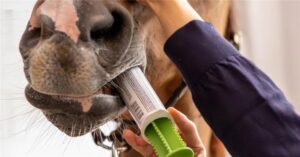
Gastro Pellet: Stomach Well-being Starts in the Mind
Anyone who spends every day around horses knows it well:…
Feed and products in 25kg bags excluded
Bank transfer | Paypal | Credit cards

Nowadays if you analyse the foods composing a sporthorse’s diet, you may easily notice that the amount of biotin they provide is scarce and variable. In other words, biotin is poorly present in plants.
After several years of researches on this sulphurated (meaning that it contains sulphur) vitamin, a new analytical parameter was defined: modern texts now report “available biotin”, not “total biotin”. Thanks to this distinction it is easy to notice that the amount of biotin the horse actually absorbs from food is way lower than expected, for biotin is often chemically bounded to substances that do not easily release it in the body. Therefore, total biotin and available biotin significantly differ in amount. The greatest sources of biotin are high-protein foods, while a diet containing great amounts of barley provides a very small quantity of available biotin. That is the reason why the quality and growth of the keratinous structures of both hooves and other parts of horses whose diet is rich in cereals, such as barley, brans and wheat (the poorest source of available biotin), is poor or even worsens. The table below shows that the amount of available biotin is higher in foods, such as dehydrated alfalfa, brewers’ yeast and dehulled soybean meal. The table values are expressed in micrograms (µg) per kilogram of raw material (a microgram is one thousandth of a milligram). Therefore, the quantities reported can only be measured with very sophisticated lab equipment and are invisible to the eye.

| RAW MATERIAL | TOTAL BIOTIN µg/kg | AVAILABLE BIOTIN µg/kg | % AVAILABLE BIOTIN/ TOTAL BIOTIN µg/kg |
| BARLEY | 180 | 12 | 6 |
| OAT | 190 | 50 | 26 |
| WHEAT | 100 | 4 | 4 |
| CORN | 100 | 65 | 65 |
| CORN GLUTEN (40% PROTEINS) | 150 | 90 | 60 |
| SOFT WHEAT BRAN | 100 | 15 | 15 |
| RICE BRAN | 380 | 12 | 3,1 |
| BREWERS’ YEAST | 970-1100 | 300 | 27 |
| SOYBEAN MEAL, DEHULLED | 350 | 280 | 80 |
| DEHYDRATED ALFALFA | 250-350 | 200-300 | 85 |
| MIXED HAY | 70 | 10 | 7 |
Let’s imagine feeding a horse with a very good ration made up of:
Total amount of available biotin: 892 µg/day, quantity that equals 0.8-0.9 mg/kg of available biotin per day. Since Roche’s estimated a daily requirement of 20 mg/day, it seems clear that horses suffer from constant available biotin deficiency. Therefore, supplementation with synthetic biotin is necessary if the horse is fed with the above raw materials, feeds based on those raw materials and cereal-based rations, which are essential to provide the energy it needs for sport activities.
Let’s hypotise that a biotin-based complementary feed provides 500 mg/kg (a very small amount) of biotin and that the daily complementary feed amount is 150 grams per day (the high amount of powder is inevitable due to the low concentration of biotin). Consequently, the horse would absorb 500 mg/kg x 0.15 kg (= 150 g) = 75 mg of biotin per day, an amount corresponding to 3.75 times the average daily requirement (20 mg/day). It is important to bear in mind that the average daily requirement refers to the minimum amount of a nutrient a healthy horse needs to maintain its health condition. Anything below this amount results in a deficiency. Therefore, in the example above, the considered amount, which is slightly higher than the average daily requirement, would not be enough to successfully treat a horse with biotin deficiency-related conditions. When required, Unika’s nutritionist suggests using of 50 g/day of Biotin Pro 3.000 in order to provide horses with 3.000 mg/kg x 0.05 kg (= 50 g) = 150 mg of biotin per day (corresponding to 7.5 times the average daily requirement). In the most severe cases, we suggest using 40 g /day of Biotin Plus 10.000, which provides 10,800 mg / kg x 0.04 kg (= 40 g) = 432 mg of biotin per day (corresponding to 21.6 times the average daily requirement). Thanks to the high concentration it provides, Biotin Plus 10.000 allows a 1/1.5 cm hoof growth per month. When required, use one or two buckets of Biotin Plus 10.000 before switching to Biotin Pro 3.000 (maintenance).
If you need any further information do not hesitate to contact us at info@lineaunika.it.

Anyone who spends every day around horses knows it well:…

Intestinal parasites are a common and often underestimated problem in…

As September approaches, the quality and nutritional composition of pastures…

As September approaches, the quality and nutritional composition of pastures…

With the arrival of warmer weather, the competition calendar gets…

The importance Assessing your horse’s physical condition and determining whether…